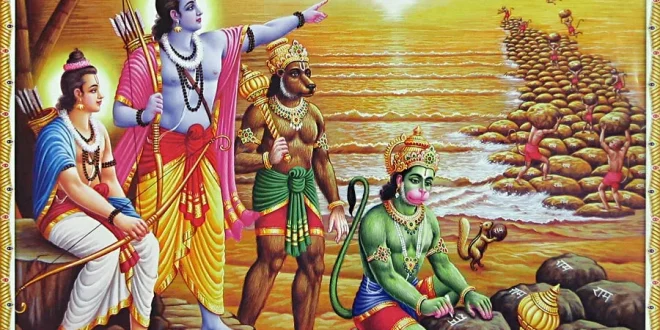Ramsetu: Valmiki Ramayana says that when Shriram marched on Lanka (Lanka.) to rescue Sita from Lankapati Ravana, he built a bridge with Nal and Neel. Nal and Neel were helped by the monkey army to build this bridge. This bridge was built using stones floating in water. These stones were brought from some other place. Many experts believe that the ‘pumice stone’ of the volcano was used in this bridge because it does not sink. Then what happened that Ramsetu sank a few feet in the water, while its stones were always going to float? Even today the stones brought from there are found floating in the water at many places in the country. One such stone is floating in water in the Alakhnath temple of Bareilly, Uttar Pradesh.
The bridge that Shri Ram built on the sea from Dhanushkodi to Sri Lanka with his army to attack Lanka was named ‘Nal Setu’. Actually, this bridge was built within 5 days by the monkeys under the supervision of the tap. It is mentioned in ‘Valmiki Ramayana’. In Ramayana, the length of this bridge has been told as 100 yojanas and width as 10 yojanas. Shrimad Valmikiya Ramayana-Katha-Sukh-Sagar, published from Geetapress Gorakhpur, describes that Shri Ram named the bridge as ‘Nal Setu’. In Mahabharata too, there is mention of Shri Ram’s Nal Setu.
Why was Dhanushkodi chosen?
It is mentioned in Valmiki Ramayana that after searching for three days, Shri Ram found a place in the sea in front of Rameshwaram, from where Sri Lanka could be easily reached. He asked to build a bridge from that place to Lanka with the help of Nal and Neel. Actually, Dhanushkodi is the only place between India and Sri Lanka, where the depth of the sea is equal to that of the river. Dhanushkodi is a village on the southern shore of Rameshwaram Island on the east coast of Tamil Nadu, India. Dhanushkodi is in the south-east of Pamban. Dhanushkodi is about 18 miles west of Talaimannar in Sri Lanka. Its name is Dhanushkodi because the shape of the bridge built by the monkey army from here to Sri Lanka is like a bow. All these areas are considered under Mannar maritime zone.
Where is the mention of Ramsetu?
There are many evidences in Valmik Ramayana that high technology was used in making the bridge. Some monkeys had brought big mountains to the beach with the help of machines. Some monkeys were holding a hundred yojan long yarn, that is, the yarn was being used in many ways in the construction of the bridge. Kalidas has described the return of Rama from the sky route in the 13th canto of ‘Raghuvansh’. In this canto, there is a description of Shri Ram telling Mother Sita about Ramsetu. The third of Skanda Purana, the fourth of Vishnu Purana, the fifth to the eleventh of Agni Purana and Brahma Purana also mention about the bridge of Shriram.
What does science say on Ramsetu?
In 1993, the US space agency NASA released to the world satellite images of a landmass emerging as a 48 km wide strip in the sea between Dhanushkoti and Pamban, northwest of Sri Lanka. After this, political controversy started in India regarding this. The terrain like this bridge came to be known as Ramsetu. Pictures of Ramsetu were taken by NASA on 14 December 1966 from Gemini-11. 22 years later, ISS-1A detected a landmass under the sea between Rameswaram and Jaffna islands off the Tamil Nadu coast. Then took his pictures. The images of the American satellite were also confirmed by these pictures.
American archaeologists also investigated
In an American TV show ‘Ancient Land Bridge’ on Science Channel in December 1917, American archaeologists had said on the basis of scientific investigation that the Hindu mythology of Shri Ram building a bridge to Sri Lanka could be true. A 50 kilometer long line between India and Sri Lanka is made of rocks. These rocks are 7000 years old. At the same time, the sand on which these rocks rest is 4000 years old. With NASA’s satellite images and other evidence, experts say, ‘It is clear from this discrepancy in the age of rocks and sand that this bridge must have been built by humans. Please tell that first of all the Muslims of Sri Lanka started calling it ‘Adam’s Bridge’. Then Christians started calling it ‘Adam’s Bridge’.
How Ram Sethu drowned in the sea?
There are two aspects of Ramsetu sinking a few feet below in the sea water. One of these is religious and the other natural. Till now researchers from all over the world have done many studies on Ramsetu. It has been said in many researches that till the 15th century one could reach Mannar Island from Rameswaram by walking on this bridge. Later, in the scientific reasons for the submergence of this bridge, it is told that the storms deepened the sea at the place of Ramsetu. At the same time, in 1480 this bridge broke down due to a cyclone. Then due to the rise in the sea level, the Ramsetu was submerged in a few feet of water. It is told for religious reasons that Vibhishan himself had requested Shri Ram to break this bridge.
Why did Vibhishan break Ramsetu
According to Padmapurana, before the war, Ravana’s brother Vibhishana had taken shelter of Shri Ram in Dhanushkodi town. After the end of the war with Ravana, Shriram made Vibhishan the king of Lanka. After this, King Vibhishan of Lanka told Shriram that the brave king of India would always use Ramsetu to attack Sri Lanka. Due to this Sri Lanka can lose its independence. He asked Shriram
 Indian Thought Latest News & Views
Indian Thought Latest News & Views



